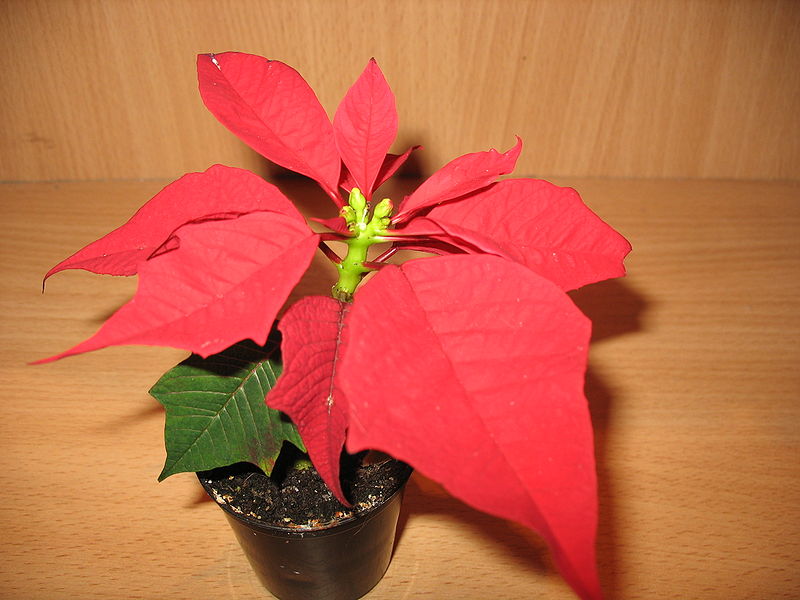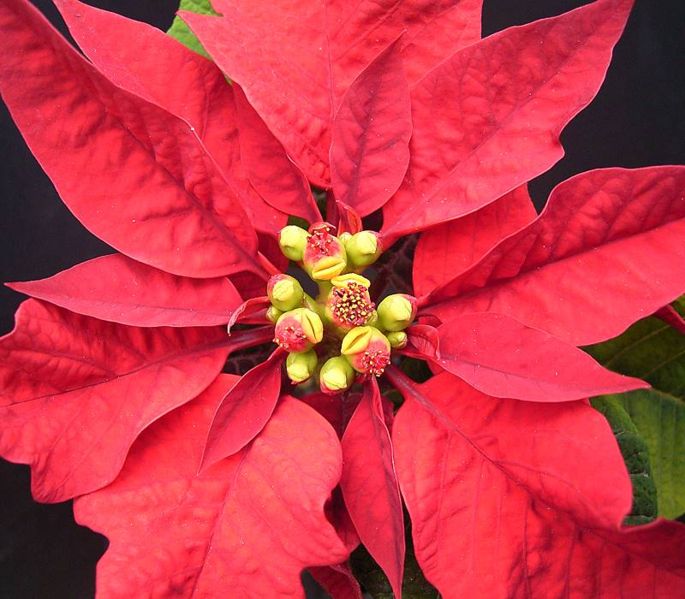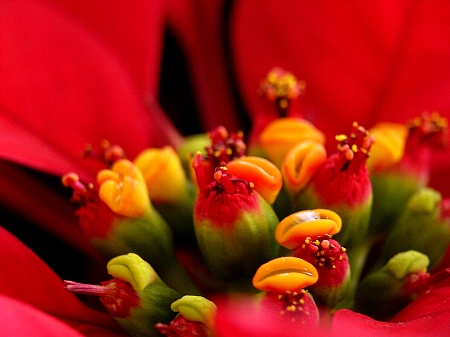Adaptations
Euphorbia pulcherrima possesses the following characteristics that allow it to survive and thrive in its environment:
Bracts
With
the poinsettia's flowers being extremely reduced, chances of cross
pollination would be highly unlikely without the help of its bracts. Bracts
are brightly colored, modified leaves
 (red, pink, and
white most commonly) that mimic flower petals and
attract pollinators such as birds and insects to the flowers. The photos to the
side demonstrate the necessity for these bracts, especially in the act of
pollination, by comparing the size of the flowers alone as compared to the
entire plant.
(red, pink, and
white most commonly) that mimic flower petals and
attract pollinators such as birds and insects to the flowers. The photos to the
side demonstrate the necessity for these bracts, especially in the act of
pollination, by comparing the size of the flowers alone as compared to the
entire plant.
Diterpene Esters
 Diterpene esters
are the poisonous substances found in many species of Euphorbia including Euphorbia
pulcherrima.
The esters are irritants and cocarcinogens which can cause abdominal pain if ingested as well as skin
irritation with
frequent exposure and eye
irritation upon contact. Although the compound
is not as toxic to humans as many think, the esters do provide the poinsettia
with great protection. Its presence causes the poinsettia to have few natural predators aside from
humans. To learn how to
care for someone experiencing problems after ingesting/contacting a
poinsettia or other poisonous
plant, consult the
GUIDE
TO POISONOUS PLANTS.
Diterpene esters
are the poisonous substances found in many species of Euphorbia including Euphorbia
pulcherrima.
The esters are irritants and cocarcinogens which can cause abdominal pain if ingested as well as skin
irritation with
frequent exposure and eye
irritation upon contact. Although the compound
is not as toxic to humans as many think, the esters do provide the poinsettia
with great protection. Its presence causes the poinsettia to have few natural predators aside from
humans. To learn how to
care for someone experiencing problems after ingesting/contacting a
poinsettia or other poisonous
plant, consult the
GUIDE
TO POISONOUS PLANTS.
Circumnutaton
The poinsettia, like other plants and animals, has processes that occur to a daily pattern known as a Circadian Rhythm. These may include photosynthesis, flower opening, and hormone production. Additionally included is what is known as circumnutaton or the "looking for the best place of sun." Once a poinsettia senses it may not be in the best position to obtain light, and therefore perform photosynthesis, the plant will slowly but surely bend in the direction of the light. The plant is able to do so via hormones known as auxins. Auxins elongate a cell and make the cell walls on the opposite side (side not facing the sun) of the stem more elastic thereby causing bending towards the light. As mentioned, this action benefits the poinsettia by increasing the amount of photosynthetic surface area being exposed to light thus increasing the amount of life-sustaining glucose being made. To see a time-lapse video of plant circumnutation, click here.
Website Created by Christine Vick
March/April 2009
Questions? Comments? Email me at vick.chri@students.uwlax.edu

